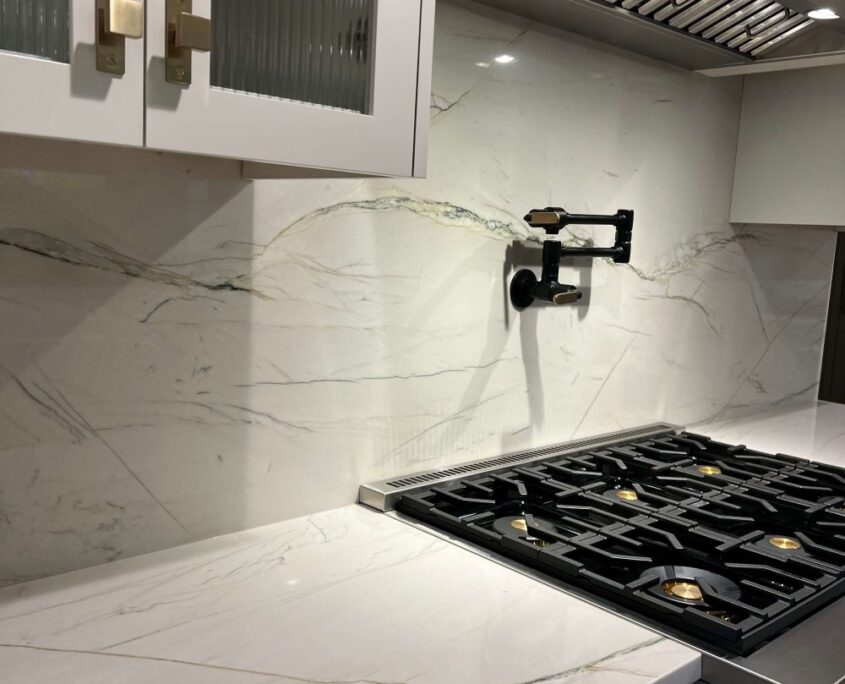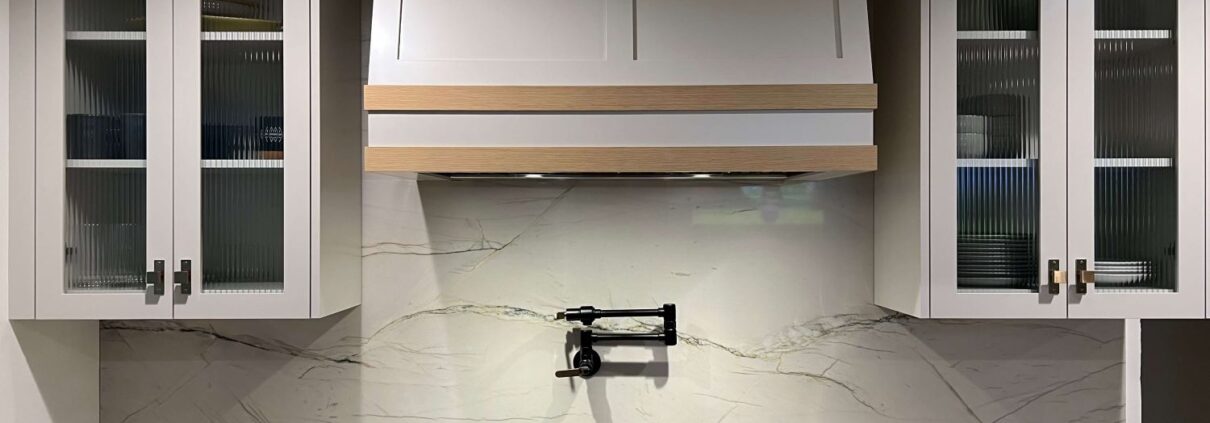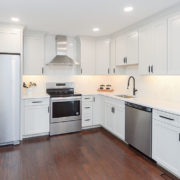How a Slab Backsplash Can Make a Room Pop
Let’s say you’re renovating your kitchen. You’ve gotten a new fridge, finished polishing your new countertop, and picked out the perfect accessories—but something’s still not right. Your kitchen just doesn’t feel complete, no matter how you reorganize your appliances. What’s missing?
When redesigning a room, it’s easy to overlook the walls, especially in a kitchen or bathroom where those walls might be predominantly taken up by cabinets. However, neglecting the spaces in between means you might miss out on a simple but effective way to make the room pop: adding a slab backsplash.
What’s a Slab Backsplash?
A slab backsplash is a continuous slab of material applied to the wall behind a sink, stove, or countertop. While their function is to protect the wall from water, food, or other “splashes”, they’re also very visually striking. They’re also relatively easy to clean due to the fact that they’re formed of a single solid slab. Backsplash slabs are usually made of stone, either natural or engineered, but they can also be made of glass or porcelain.
Slab vs. Tile Backsplash
If you’ve dabbled in interior design and backsplashes before, you may already be familiar with tile backsplashes. Like slab backsplashes, tile backsplashes cover the wall behind the sink, stove, or countertop. The difference between the two is that tile backsplashes are formed from a layer of tiles, as opposed to a solid slab.
There are many benefits to a tile backsplash. Using tile gives you access to a wide variety of colors, patterns, and even textures. If part of the backsplash gets damaged, you can simply replace the affected tiles instead of redoing the entire wall. However, a full slab backsplash is generally easier to clean due to the lack of seams. Dirt can easily accumulate on tile backsplashes, staining the grout and making it look grimy without regular cleanings. Ultimately, the choice between a solid slab backsplash or a tile backsplash comes down to three factors: your budget, the amount of time you can dedicate to maintenance, and personal preference.
How to Utilize a Backsplash
Slab backsplashes are highly versatile due to the variety of colors and materials available. They can be placed behind sinks, stoves, and countertops in almost any kitchen or bathroom, although they work best with sleeker, more modern applications. They also work well in places with an opportunity for material synergy: for example, if your kitchen has granite countertops, a backsplash in the same shade can create a feeling of unity.

This marbled slab backsplash mirrors the kitchen countertop pattern, creating a sense of continuity and breathtaking elegance.
Slab Backsplash Ideas
Looking for ways to make a slab backsplash your own? Here are a few ideas to help set yours apart:
Colored Backsplash
While many people use neutral tones such as white, gray, or beige for their backsplashes, bold colors can have a powerful effect when used properly. Darker colors can be offset with lighter cabinets to provide fun visual contrast. Just be sure to use it in moderation, especially if it’s a dark color—if used in excess, it can make a room feel cramped and gloomy.
Porcelain Slab
Porcelain slabs have gained popularity in the past few years, and are quickly becoming one of the most popular materials for slab backsplashes. They’re lighter and more affordable than marble but can be patterned to look like natural stone. This makes them perfect for those who want the look of a marble backsplash but can’t afford the material.
Glass Slab
Not a fan of stone or porcelain? Try a glass sheet backsplash. These slabs can be painted different colors to match your kitchen’s decor or left clear to provide a glossy protective layer over the kitchen wall.
Adding a Shelf
If you want to spice up a pre-existing backsplash without redoing the whole thing, try adding a shelf. Not only will this break up the backsplash without forcing you to use tiles, it also creates usable storage space.
Add a Splash of Class with Ayars Home Improvements
If you’re interested in a slab backsplash as part of your next kitchen or bathroom remodel, we would love to work with you to complete your vision. Our intake process is as follows:
- Tell us about your project via phone or our online form.
- Determine if we are the Right Fit for one another, based on timetable, project scope, and shared home remodeling sensibilities — we want to work with people who care as much as we do!
- Chat with interior design consultant Sharon Vick or visit our new design showroom to get your inspiration flowing on materials and finishes.
- We’ll determine the timeline for your project based on the availability of labor and materials, and show up on Day 1 ready to apply our craftsman’s touch!
We hope to hear from you soon!





